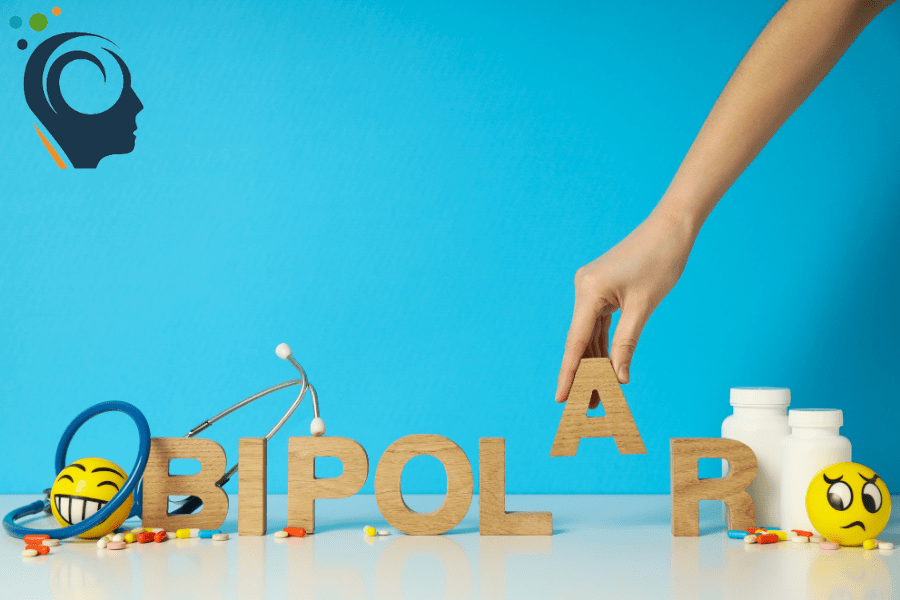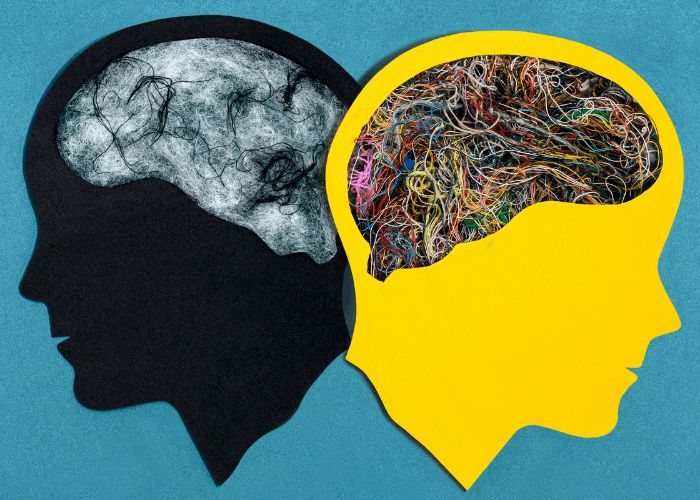Bipolar Disorder, a complex mental health condition characterized by extreme mood swings, affects millions worldwide. These mood swings include emotional highs (mania or hypomania) and lows (depression), which can significantly impact an individual’s daily life, relationships, and overall well-being. Understanding the causes of Bipolar Disorder is crucial in developing effective treatments and providing support for those affected. In this blog post, we will explore the multifaceted causes of Bipolar Disorder, delving into genetic, biological, environmental, psychological, and societal factors. By examining these various elements, we can gain a comprehensive understanding of what contributes to this challenging condition.
1. Genetic Factors
Family History
Research has consistently shown that Bipolar Disorder tends to run in families, indicating a strong genetic component. Individuals with a first-degree relative (such as a parent or sibling) who has Bipolar Disorder are at a significantly higher risk of developing the condition themselves. This familial link suggests that specific genes may be inherited, increasing susceptibility to Bipolar Disorder.
Genetic Studies
Genetic research has identified several genes that may be associated with Bipolar Disorder. Studies have pinpointed gene variations related to neurotransmitter regulation, brain cell communication, and circadian rhythms, all of which play crucial roles in mood regulation. However, no single gene is solely responsible for the disorder; rather, it is likely a combination of multiple genetic factors interacting with each other and environmental influences.
2. Biological Differences
Brain Structure and Function
Brain imaging studies have revealed structural and functional differences in the brains of individuals with Bipolar Disorder compared to those without the condition. For instance, abnormalities in the prefrontal cortex, which is involved in decision-making and impulse control, and the limbic system, which regulates emotions, have been observed. These differences may contribute to the emotional instability and impaired judgment seen in Bipolar Disorder.
Neurotransmitter Imbalances
Neurotransmitters, the brain’s chemical messengers, play a vital role in regulating mood. Imbalances in neurotransmitters such as serotonin, dopamine, and norepinephrine have been implicated in Bipolar Disorder. For example, elevated dopamine levels are associated with manic episodes, while decreased serotonin levels are linked to depressive episodes. These imbalances can disrupt normal brain function, leading to the extreme mood swings characteristic of Bipolar Disorder.
3. Environmental Factors
Stressful Life Events
Stressful life events, such as the loss of a loved one, divorce, or financial difficulties, can trigger or exacerbate Bipolar Disorder symptoms. These events can lead to significant emotional stress, which may destabilize mood and precipitate manic or depressive episodes. While stress alone does not cause Bipolar Disorder, it can act as a catalyst for individuals already predisposed to the condition.
Substance Abuse
Substance abuse, particularly the use of drugs and alcohol, is closely linked to Bipolar Disorder. Substance use can exacerbate symptoms, trigger mood episodes, and complicate treatment. Additionally, individuals with Bipolar Disorder may turn to substances as a way to self-medicate, creating a vicious cycle that worsens their condition. Addressing substance abuse is crucial in managing Bipolar Disorder effectively.
4. Psychological Factors
Personality Traits
Certain personality traits may predispose individuals to Bipolar Disorder. Traits such as impulsivity, emotional instability, and high levels of neuroticism have been associated with increased risk factors for developing the condition. These traits can make individuals more vulnerable to mood swings and less capable of coping with stress, contributing to the onset and progression of Bipolar Disorder.
Cognitive Patterns
Negative thinking patterns and cognitive distortions, such as all-or-nothing thinking, catastrophizing, and excessive rumination, can contribute to Bipolar Disorder. These cognitive patterns can exacerbate depressive episodes and increase the likelihood of manic episodes by fostering unrealistic expectations and heightened emotional reactivity. Cognitive-behavioral therapy (CBT) can help individuals with Bipolar Disorder identify and modify these harmful thought patterns.
5. Medical Conditions and Medications
Co-occurring Medical Conditions
Certain medical conditions, such as thyroid disorders, can influence mood stability and contribute to Bipolar Disorder symptoms. Hypothyroidism, for instance, can lead to depressive symptoms, while hyperthyroidism can cause manic-like symptoms. It is essential to address these underlying medical conditions to manage Bipolar Disorder effectively.
Medication Side Effects
Some medications, particularly those affecting the central nervous system, can trigger or worsen Bipolar Disorder symptoms. For example, antidepressants prescribed for unipolar depression can sometimes induce manic episodes in individuals with Bipolar Disorder. Close monitoring by a healthcare professional is necessary when prescribing medications to individuals with or at risk for Bipolar Disorder.
6. Hormonal Imbalances
Hormonal fluctuations, particularly those involving cortisol (the stress hormone), can significantly impact mood regulation. Elevated cortisol levels, often seen in response to stress, can contribute to the development and exacerbation of Bipolar Disorder symptoms. Hormonal imbalances can disrupt the delicate balance of neurotransmitters, leading to mood instability.
Gender Differences
Bipolar Disorder may manifest differently in men and women, possibly due to hormonal differences. Women are more likely to experience rapid cycling (four or more mood episodes in a year) and mixed episodes (simultaneous symptoms of mania and depression). Hormonal changes related to the menstrual cycle, pregnancy, and menopause can also influence the course of Bipolar Disorder in women.
7. Childhood Trauma and Early Life Stress
Adverse Childhood Experiences (ACEs)
Adverse childhood experiences, such as physical, emotional, or sexual abuse, neglect, and exposure to domestic violence, can have long-lasting effects on mental health. These experiences can alter brain development and increase the risk of developing Bipolar Disorder later in life. Early intervention and support for children exposed to trauma are crucial in mitigating these long-term effects.
Attachment Issues
Early bonding and attachment with primary caregivers are vital in emotional development. Disrupted attachment, such as inconsistent caregiving or parental neglect, can lead to difficulties in regulating emotions and increase the risk of Bipolar Disorder. Secure attachment provides a foundation for healthy emotional development, reducing the likelihood of developing mood disorders.
8. Societal and Cultural Factors
Stigma and Discrimination
Societal attitudes toward mental illness can significantly impact individuals with Bipolar Disorder. Stigma and discrimination can lead to social isolation, decreased self-esteem, and reluctance to seek help. These factors can exacerbate symptoms and hinder effective management of the condition. Promoting awareness and reducing stigma are essential in supporting individuals with Bipolar Disorder.
Cultural Differences in Diagnosis and Treatment
Cultural perceptions of mental health can influence the diagnosis and treatment of Bipolar Disorder. In some cultures, symptoms of Bipolar Disorder may be misunderstood or attributed to spiritual or supernatural causes, leading to delayed diagnosis and inadequate treatment. Culturally sensitive approaches to mental health care are necessary to ensure accurate diagnosis and effective treatment for individuals from diverse backgrounds.
9. Emerging Research
Epigenetics
Emerging research in epigenetics explores how environmental factors can affect gene expression and contribute to the development of Bipolar Disorder. Epigenetic changes, such as DNA methylation and histone modification, can influence how genes associated with Bipolar Disorder are expressed. Understanding these mechanisms may lead to new insights into the causes and treatment of the condition.
Gut-Brain Axis
Recent studies have highlighted the connection between gut health and mental health, known as the gut-brain axis. The gut microbiome, the community of microorganisms in the digestive tract, can influence brain function and mood regulation. Imbalances in the gut microbiome have been linked to various mental health conditions, including Bipolar Disorder. Research in this area may uncover new avenues for treatment, such as probiotics and dietary interventions.
FAQs
Q: What is Bipolar Disorder?
(A): Bipolar Disorder is a mental health condition characterized by extreme mood swings, including emotional highs (mania or hypomania) and lows (depression).
Q: Can Bipolar Disorder be inherited?
(A): Yes, Bipolar Disorder tends to run in families, indicating a strong genetic component. Having a first-degree relative with the condition increases the risk.
Q: How do neurotransmitter imbalances affect Bipolar Disorder?
(A): Imbalances in neurotransmitters such as serotonin, dopamine, and norepinephrine can disrupt normal brain function and contribute to the mood swings characteristic of Bipolar Disorder.
Q: Can stress trigger Bipolar Disorder?
(A): While stress alone does not cause Bipolar Disorder, it can trigger or exacerbate symptoms in individuals already predisposed to the condition.
Q: What role do hormonal imbalances play in Bipolar Disorder?
(A): Hormonal fluctuations, particularly those involving cortisol, can significantly impact mood regulation and contribute to Bipolar Disorder symptoms.
Q: How does childhood trauma influence Bipolar Disorder?
(A): Adverse childhood experiences and early life stress can alter brain development and increase the risk of developing Bipolar Disorder later in life.
Some Key Points
- Bipolar Disorder is influenced by genetic, biological, environmental, psychological, and societal factors.
- Family history and genetic variations play a significant role in the risk of developing Bipolar Disorder.
- Brain structure and neurotransmitter imbalances contribute to mood instability.
- Stressful life events, substance abuse, and hormonal imbalances can trigger or worsen symptoms.
- Childhood trauma and disrupted attachment can increase the risk of Bipolar Disorder.
- Societal stigma and cultural perceptions can affect diagnosis and treatment.
- Emerging research in epigenetics and the gut-brain axis offers
Conclusion
Understanding the causes of Bipolar Disorder is essential in developing effective treatments and providing support for those affected. The condition is influenced by a complex interplay of genetic, biological, environmental, psychological, and societal factors. Ongoing research sheds light on these causes, offering hope for improved management and treatment options. By adopting a holistic approach that considers all these factors, we can better support individuals with Bipolar Disorder and promote their well-being. For more information or support, please contact us at Conscientia Health. We’re here to help.














